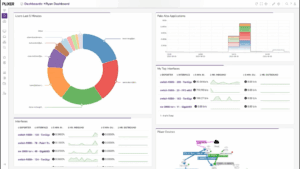While headlines focus on dramatic breaches and ransomware attacks, on campus the real threats often hide in plain sight: that IoT device with unusual traffic patterns, the shadow application streaming research data to unknown endpoints, or the performance degradation that masks malicious activity during peak academic periods.
For NetOps and SecOps teams in higher education, these invisible risks represent a fundamental challenge. Unlike enterprise environments with controlled device policies and predictable user patterns, campus networks must balance openness with security, innovation with compliance, and performance with protection—all while operating under budget constraints and supporting increasingly complex hybrid learning models.
The Perfect Storm: Why Campus Networks Are Under Siege
Higher education environments face a unique cocktail of security and performance challenges. Unlike corporate networks, campus networks are essentially open ecosystems where unpredictability is a given.
Consider what your network handles on any given day:
- Thousands of unmanaged personal devices from students, faculty, and visitors
- Legacy academic systems that can’t be easily updated or replaced
- IoT devices proliferating across smart classrooms and research facilities
- Guest access requirements for conferences, events, and visiting scholars
- Research data flows that demand both high performance and strict security
- Hybrid learning platforms supporting both on-campus and remote students
Each of these elements introduces potential blind spots where threats can hide and performance issues can fester.
The Invisible Threat: When That “Printer” Isn’t Just Printing
Remember that network printer that seemed to be using way more bandwidth than it should? Your instincts were right to flag it. In today’s campus environment, compromised IoT devices are increasingly becoming pivot points for lateral movement attacks.
Here’s why these scenarios are becoming more common:
Default credentials remain unchanged on many campus IoT devices, from smart projectors to environmental sensors. Attackers know this and systematically probe for these easy entry points.
Device sprawl creates visibility gaps. When you can’t see what every device is doing on your network, unusual behavior can go unnoticed for months. That “quiet” printer in the library might actually be exfiltrating research data or participating in a botnet.
Shadow IT compounds the problem. Students and faculty often deploy their own devices and applications without going through proper channels, creating additional attack surfaces that traditional monitoring tools miss entirely.
The challenge isn’t just identifying these rogue devices—it’s understanding their behavior patterns and network interactions quickly enough to prevent damage.
Registration Rush: When Performance Issues Mask Security Threats
Peak traffic events like course registration reveal more than just bandwidth limitations. They expose the fundamental visibility gaps that plague many campus networks. When a student hits “Register” and the system freezes, it’s easy to blame a bandwidth spike. But what if that freeze was actually caused by a DDoS attack timed to coincide with high-traffic periods?
The Performance-Security Intersection
Campus network teams often treat performance and security as separate domains, but they’re more and more intertwined:
- Anomalous traffic patterns during peak usage can indicate both legitimate load and malicious activity
- Application slowdowns might result from network congestion or ongoing data exfiltration
- DNS floods can emerge during high-traffic academic periods, masking more targeted attacks
Without unified visibility into both performance metrics and security indicators, teams end up playing whack-a-mole with symptoms rather than addressing root causes.
The Shadow IT Challenge: Students as Unwitting Accomplices
Students don’t set out to compromise network security, but their behavior patterns create significant risks. The same innovation and experimentation that drive academic success can also open doors for attackers.
Consider these common scenarios:
The capstone project that goes viral. A student team creates a popular campus app that gains serious traction. Thousands download it, traffic spikes, and suddenly you’re dealing with both performance issues and potential security implications of an unvetted application spreading across your network.
The research collaboration that bypasses IT. A professor needs to share large datasets with colleagues at other institutions. Rather than wait for official channels, they sign up for a cloud service and start transferring sensitive research data, potentially violating compliance requirements and creating new attack vectors.
The gaming setup that becomes a backdoor. That late-night lag a student experienced might have been caused by malware on a gaming device that’s now providing remote access to your network for cryptocurrency mining or worse.
Beyond the Obvious: Encrypted Traffic and Hidden Communications
Modern threats don’t always announce themselves with suspicious port scans or malware signatures. Sophisticated attacks hide within encrypted traffic and legitimate-looking communications.
The Encryption Dilemma
While encryption protects legitimate data, it also provides cover for malicious activity. Traditional monitoring tools often go blind when faced with encrypted traffic, leaving teams with incomplete visibility into potential threats.
Some network observability platforms can analyze encrypted traffic without decryption by examining:
- Flow patterns and timing that indicate unusual communication behaviors
- Certificate anomalies that suggest man-in-the-middle attacks or rogue services
- Bandwidth utilization patterns that don’t match expected application profiles
- Connection metadata that reveals suspicious endpoints or protocols
This approach allows you to maintain privacy and compliance while still detecting threats hiding in encrypted channels.
The Compliance Tightrope: Balancing Openness with Protection
Higher education institutions must navigate complex compliance requirements while maintaining the open, collaborative environment that defines academic culture. FERPA, HIPAA (for medical research), and various grant requirements create overlapping obligations that can seem at odds with network openness.
The key challenge areas include:
Data classification and handling across diverse research projects and student information systems. Without clear visibility into data flows, ensuring appropriate protections becomes nearly impossible.
Access control in open environments where the principle of least privilege conflicts with academic collaboration needs. Students and faculty need broad access to resources, but traditional security models struggle with this flexibility.
Incident response in distributed environments where threats can spread across multiple departments, research groups, and even partner institutions before being detected.
Proactive Defense: From Reactive Firefighting to Intelligent Prevention
The traditional approaches to campus network security no longer suffice. Today’s threats require proactive, intelligence-driven defense strategies that can adapt to the unique challenges of higher education.
Building Comprehensive Visibility
Effective campus network security starts with comprehensive visibility across all network segments, device types, and traffic flows. This means moving beyond traditional perimeter-focused monitoring to embrace:
- Flow analysis that reveals communication patterns and anomalies across all network segments
- Behavioral analytics that establish baselines for normal activity and flag deviations
- Cross-correlation capabilities that connect seemingly unrelated events into coherent threat narratives
- Contextual alerting that enables rapid response before minor issues become major incidents
Integrating Performance and Security Operations
The artificial separation between NetOps and SecOps teams creates dangerous blind spots. Modern campus networks require integrated approaches where performance monitoring and security analysis inform each other.
For example, that traffic spike during midterms might just be a performance issue—but it also might indicate a DNS flood attack, timed to exploit high-traffic periods when unusual activity is more likely to be dismissed as legitimate load.
Reducing Alert Fatigue
Traditional security tools often overwhelm teams with low-quality alerts that obscure genuine threats. Observabilty platforms use AI/ML-driven analysis to:
- Prioritize alerts based on actual risk rather than rule-based triggers
- Provide context that helps analysts quickly understand threat significance
- Suggest remediation steps based on similar incidents and proven responses
- Correlate events across time and network segments to reveal attack campaigns
This approach allows smaller teams to focus on genuine threats rather than chasing false positives.
Future-Proofing Campus Networks
The challenges facing campus networks will only intensify as digital transformation accelerates. Hybrid learning models, edge computing deployments, and increasing IoT adoption create new attack surfaces and complexity.
Forward-thinking institutions are investing in platforms that can evolve with these challenges by providing:
Scalable architecture that adapts to changing network topologies and traffic patterns without requiring complete overhauls.
API-driven integration that connects with existing security tools and campus systems to create unified defense ecosystems.
Machine learning capabilities that improve threat detection and reduce false positives over time.
Compliance automation that helps maintain regulatory requirements without manual overhead.
Concluding Thoughts
In a well-protected campus environment, a student’s research session goes smoothly because network intelligence platforms have identified and mitigated the real cause of performance issues. A professor’s research portal loads quickly because security tools have eliminated the threats that were consuming bandwidth and degrading performance.
The difference is in having the right visibility, intelligence, and response capabilities in place before problems occur.
To see how our observability and defense platform can help eliminate blind spots in your campus network, book a Plixer One demo with one of our engineers.



